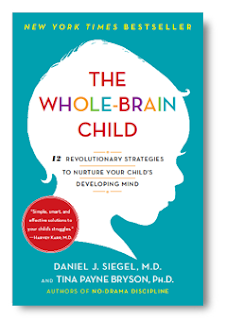When a child does something that’s unfavorable, we tend to react without much thought. We know what’s right and we feel it’s in their best interest to tell them immediately what they need to fix. However, what I noticed about myself when I would immediately react was that I was stressed and unreasonably irritable at the end of the day. This then made it more difficult for me to enjoy my time with each child that was in my care. And in honest reflection, it wasn’t working for them either.
I began reading books about the brain, our language choices, and behavior management. As soon as I put even one new strategy into practice I had an instant feeling of relief and less burden at the end of each day. The Whole-Brain Child by Daniel J. Siegel and Tina Payne Bryson was one of these books.
The strategies you learn in this book lend themselves more to a child’s difficult emotional moments, whereas a book like Love & Logic has more strategies for the day-to-day practices with your child.
Before assuming that every big emotional reaction from a child means something, Siegel and Payne point out that often one of these emotional responses could just be the child seeking a basic need. The acronym they use to help you remember to look for these needs is H.A.L.T. Is our child/student hungry, angry, lonely, or tired?
The book begins by explaining four sections of the brain and how they work together for a positive, healthy way of living. Being conscious of how these section integrate better allows you to use their suggested strategies more effectively. The strategies are to help teach children how to be in charge of their actions and emotions.
The Montessori Notebook made a great quick-guide PDF to these strategies. Since this book applies two-fold for me (teacher and parent), I’ve decided to recently listen to the audio book again. The first time I listened, I could not soak up the information fast enough. This time through, I’m stopping after each chapter to reflect and discuss with my husband. Have we noticed this with our two-year-old? What could we do differently next time he does ____? After these discussions, my wonderful partner is allowing me to take over our bathroom mirror as a way to store our new learning and remind us to practice it.

Understanding how to effectively deliver these strategies with care and compassion is not only a benefit to our children, but in turn gives us more patience when handling our children’s emotional reactions. This not only gives them life skills to help them lead healthy lives, one day independently, but also allows us to end our day more relaxed and excited to wake up and do it again.
